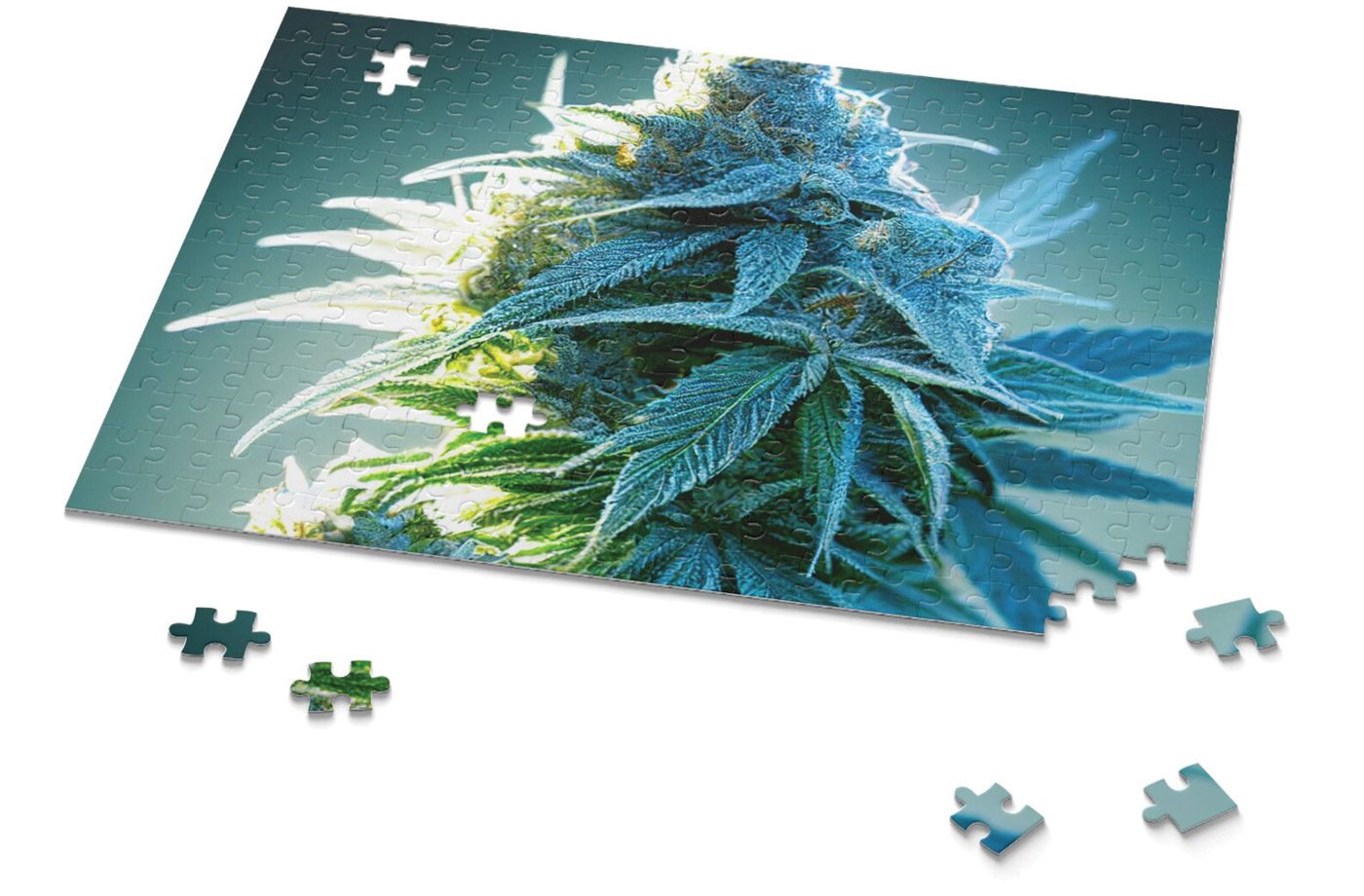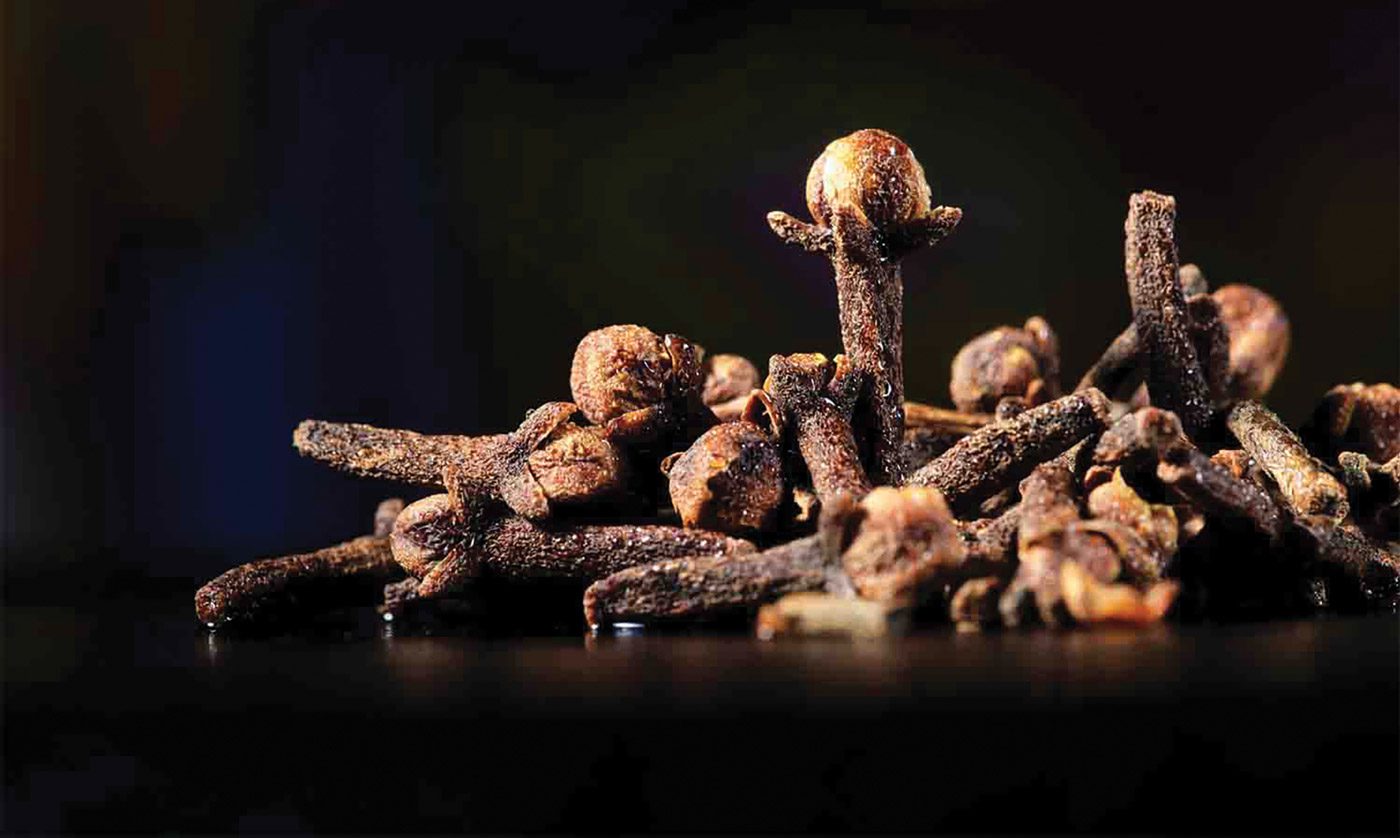“Back in the day, good weed was spicy, now it’s so sweet!”
Myrcene is a single terpene with unique characteristics that expand its single molecule complexity. While myrcene is the most common monoterpene found in cannabis, many of the most widely occurring sesquiterpenes are caryophyllenes, a family of structurally and biosynthetically related compounds that often appear together in cannabis samples. This diversity underscores the significance of caryophyllene and its benefits within the broader spectrum of terpenes in cannabis.
THE CARYOPHYLLENE FAMILY
The caryophyllenes as a family are characteristically woody and spicy, yet each individual compound also has its unique fragrance and flavor profile. The parent compound is caryophyllene itself (AKA beta-caryophyllene or trans-caryophyllene), a pale-yellow oily liquid with a spicy and peppery clove-like aroma and flavor with turpentine, camphor, and astringent citrus undertones.
Like myrcene, caryophyllene is widely found throughout the plant kingdom. It occurs in many green leafy vegetables, herbs, and spices. It is a major constituent of basil, calamus, rosemary, and hop essential oils, and accounts for the spiciness of black pepper and clove oil, as well as the spicy taste of Cannabis essential oil and the “hoppy” aroma of beer. Caryophyllene is also found in significant amounts in catnip and is added to tobacco to enhance its flavor.
Hybrid sinsemilla cultivars reported to contain relatively high levels of caryophyllene include S.A.G.E. (11.0%) and Zeta (10.0%), Skunk No. 1 (0.5 to 16.1%), Hash Plant, and Diablo OG (both 1.0%), and others at 3.8 to 31.4% of the terpenes. Caryophyllene is also found in European hemp essential oil at 3.8 to 37.5%, in Himalayan “wild” samples at 19.6 to 26.1%, and in Indian ganja at 45.7%, indicating that caryophyllene is prevalent in many landraces and was found in many batches of traditional imported weed, especially Colombian and Mexican.
Caryophyllene is usually found as a mixture with other members of the family such as humulene, an isomer of caryophyllene with the same chemical formula but a slight rearrangement of atoms. Humulene (AKA alpha-caryophyllene) is a pale, yellowish-green, clear liquid with a characteristically woody, bitter, and hoppy aroma, that oxidizes rapidly and loses its aroma quickly when exposed to air. Humulene was first found in the hop plant Humulus lupulus from which it derives its name. In brewer’s hop cultivars, humulene occurs in much larger amounts than caryophyllene and can constitute up to 40% of its essential oil. It is the predominant terpene in some hop varieties, but levels are generally less than that of myrcene. Humulene is also found in pine, orange, coriander, sage, ginseng, and mint oils.
The humulene content of European “hemp” oils ranges from 0.7 to 7.4%, “wild” Austrian levels range from 3.2 to 6.0%, Himalayan “wild” from 5.4 to 7.8%, Indian ganja 1.3 to 16.0%, and sinsemilla cultivars 0.7 to 3.4% including Zeta (3.3%) and S.A.G.E. (3.1%), while in fresh Skunk No. 1 humulene constitutes 2.8% of the terpene fraction.
It is interesting to note that in reference to this limited data, modern hybrid cultivars contain less caryophyllene and humulene than both European “hemp” cultivars and South Asian landrace plants. Was humulene bred out of sinsemilla cultivars in favor of myrcene?
Another relatively rare caryophyllene isomer is iso-caryophyllene (AKA gamma-caryophyllene), that takes all forms from a pale-yellow clear liquid to a solid compound and also shares a woody and spicy aroma, but is reported in only trace amounts. European “hemp” oil reportedly contains 0.10 to 0.19% and Skunk No. 1 contains 0.02% of the total terpenes.
Several of the caryophyllenes are terpenoid compounds modified by additions of alcohol (OH) or oxygen (O) groups to the caryophyllene molecule. Caryophyllene oxide is a white to pale yellow crystalline solid with a fresh, dry, and woody, spicy-sweet aroma with lemony notes, and a dry, woody carrot flavor. Caryophyllene oxide is a broad-scale insect-feeding deterrent with antifungal properties found in many plants, and is a major constituent of rose, lavender, lemon verbena, thyme, pine, Eucalyptus, and cedar oils. Caryophyllene oxide is a relatively stable compound with a higher vaporization point than other caryophyllenes and at least trace amounts are present in most Cannabis. However, since caryophyllene oxide results from the oxidative degradation of caryophyllene over time, it is less prevalent in fresh Cannabis and occurs at higher levels in older cannabis samples and extracts than in fresh flowers.
Caryophyllene oxide is reported at relatively high levels in imported cannabis samples and is the molecule that drug-sniffing dogs are trained to detect in illicit shipments. European hemp oils reportedly contain traces to 11.3%, Austrian “wild” populations contain 7.0 to 16%, “wild” Himalayan bhang contains 2.0 to 10.7%, Indian ganja contains 1.7%, and in fresher samples of sinsemilla cultivars including Skunk No. 1, there were only traces to 0.9% reported. Also occurring in Cannabis in small amounts is caryophyllene alcohol, a clear and colorless liquid with an earthy, spicy, mossy, and resinous aroma. Caryophyllene alcohol has been reported at low levels in European “hemp” essential oil at 0.1% and at 0.7% in “wild” Himalayan plants, yet it has not been reported in modern hybrid sinsemilla cultivars.
CARYOPHYLLENES ARE PERSISTENT
One of the primary explanations for the differing aromas and flavors of weed imported in the 1970s compared to modern sinsemilla is that, as in modern sinsemilla cultivars, caryophyllene is often present with high levels of myrcene, highlighting the caryophyllene benefits. Resulting from the rigors of varying and largely warm storage temperatures during transport from faraway lands, myrcene and other more volatile (lower vaporization temperature) monoterpenes disappeared. In addition, over time, caryophyllene is slowly converted to more stable caryophyllene oxide. Less-volatile sesquiterpenes generally persisted during transport and by default became the signature terpenes, specifically the caryophyllenes, responsible for the wonderful spicy fragrances and flavors now fondly remembered by early connoisseurs. The caryophyllenes are also more persistent in cannabis extracts and concentrates than the lower-boiling-point terpenes, and caryophyllene oxide, a notable component among terpenes in cannabis, can form from the heat of extraction.
MEDICINAL PROPERTIES OF CARYOPHYLLENES
Caryophyllene has been shown to have antiseptic, antibacterial, antifungal, antioxidant, anticarcinogenic, local anesthetic, and especially anti-inflammatory properties, as well as regulating blood lipid content and impeding the pressure exerted by heart muscles. Caryophyllene’s anti-inflammatory and analgesic powers are responsible for the efficiency of clove oil in relieving toothache pain. As an agonist of CB2 receptors located mainly in the immune system, it also exerts gastroprotective, analgesic, antidepressant, antiproliferative, antioxidant, anxiolytic, and neuroprotective effects.
Caryophyllene may prove useful in the treatment of anxiety, arthritis, diabetes, depression, calcium- and potassium-ion channel disorders, autoimmune disorders, ulcers, and other gastrointestinal indications, as well as in pain management, ameliorating Alzheimer symptoms, cancer treatment, and alcoholism therapy. Caryophyllene may also modify the effects of cannabinoids that bind to CB2 receptors, which opens the possibility that other terpenes may also bind to endocannabinoid receptors and elicit similar or other synergistic effects on the primary medicinal cannabinoids.
Both caryophyllene and humulene are used in traditional Chinese medicine to relieve inflammation. Caryophyllene has also been shown to have potentiating effects (in which one chemical maximizes the effect of another one) on the anticancer activity of humulene and iso-caryophyllene against human tumor cell lines. Humulene produces antibacterial, analgesic, and anti-inflammatory effects and, like caryophyllene, exhibits potential in the management of pain and inflammation. It is also an appetite suppressant and could be useful in weight control and may also possess anti-proliferative properties possibly useful in cancer therapies.
The caryophyllene terpenoids also possess potential medicinal values. Caryophyllene alcohol may also possess antifungal and antioxidant properties. Caryophyllene oxide, similar to its parent compound caryophyllene, exhibits strong anti-inflammatory activity. Brain stimulation is a reported medical benefit, and caryophyllene oxide may find therapeutic use in treating neurological disorders.
CARYOPHYLLENES AND THE ENDO-CANNABINOID SYSTEM
The endocannabinoid system helps maintain homeostasis (physiological equilibrium) within our brains and bodies and is activated through receptors to which various molecules bind and exert their effects. THC activates both the CB1 receptor responsible for modulating its psychoactive effects as well as the CB2 receptor modulating various physical functions within the human body. CBD binds only to the CB2 receptor and therefore is not psychoactive.
Caryophyllene, a significant terpene in cannabis, has also been shown to bind to the CB2 receptor and may exert cannabimimetic (cannabinoid-like) effects, opening up the possibility that caryophyllene and possibly other related terpene molecules may be valuable in the treatment of inflammation and associated pain. Because caryophyllene binds to the CB2 receptor, and because it does not cause significant psychoactive effects, it is allowed as an additive in foods and beverages. Although caryophyllene is found in many plants, when consumed orally it is considered by many to be a “dietary” cannabinoid, highlighting the caryophyllene benefits in the context of terpenes in cannabis. Vaporized caryophyllenes may also induce medicinally beneficial effects. In 2019, the Napro Research group was granted a patent claiming that vaporized caryophyllene and humulene demonstrate “beneficial physiological effects’ ‘ that are not experienced when either terpene is administered orally.
In conclusion, the caryophyllenes, key terpenes in cannabis, are still found in modern sinsemilla, although their spicy flavors and aromas are often masked by the more fruity and sweet monoterpenes such as myrcene that are now prevalent in many popular “dessert” varieties. Cannabis imported from distant lands during the 1970s and 1980s often lacked the more volatile monoterpenes lost during transport and the spicy caryophyllenes were much more apparent. However, there are several caryophyllene-rich modern sinsemilla cultivars and if spicy and woodsy are your favored aromas and flavors, they are still available today, further underscoring the benefits of caryophyllene among the terpenes in cannabis.




